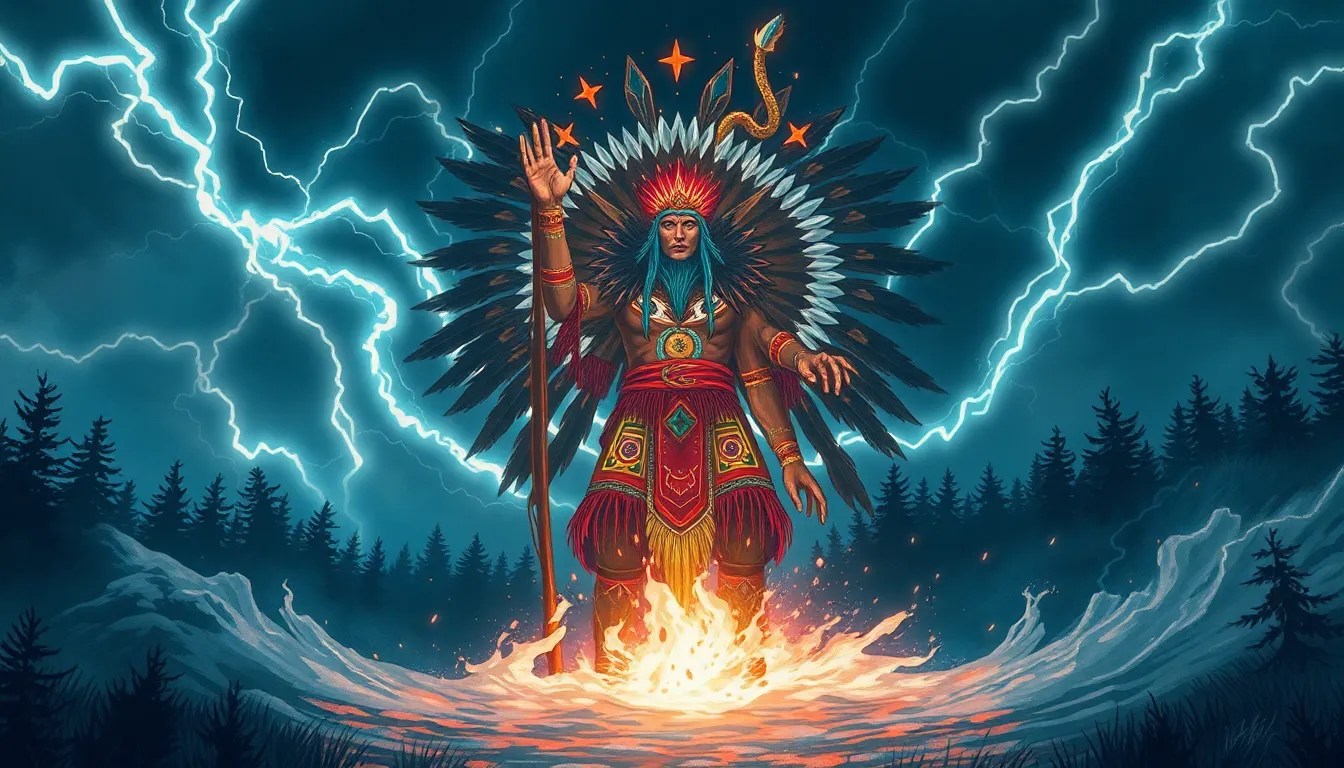The Legend of the Thunder Spirit: Ojibwe Myths of Power and Protection
I. Introduction
Ojibwe mythology is rich with stories and teachings that reflect the values, beliefs, and relationship with nature of the Ojibwe people. Central to this mythology is the figure of the Thunder Spirit, a powerful entity revered for its strength and protective qualities. This article aims to explore the legend of the Thunder Spirit, its origins, characteristics, and its significance in Ojibwe culture.
II. The Thunder Spirit: Origins and Characteristics
The Thunder Spirit, known as Gizhe Manidoo in the Ojibwe language, is often depicted as a large, powerful figure associated with storms, thunder, and lightning. The Thunder Spirit embodies the raw power of nature and is both feared and respected by the Ojibwe people.
Symbolism plays a crucial role in understanding the Thunder Spirit:
- Thunder: Represents strength, power, and the voice of the Creator.
- Lightning: Symbolizes illumination, guidance, and the connection between the spiritual and physical worlds.
- Storms: Serve as a reminder of nature’s unpredictability and the need for respect and balance.
As a protector, the Thunder Spirit is believed to guard the Ojibwe people from malevolent forces and provide them with strength in times of need. This protective aspect makes the Thunder Spirit a vital figure in Ojibwe spirituality.
III. The Role of the Thunder Spirit in Ojibwe Creation Stories
The Thunder Spirit plays a significant role in Ojibwe creation narratives, often depicted as a key figure in the formation of the world. In these stories, the Thunder Spirit interacts with various beings, including animals, plants, and humans, shaping the environment and ensuring harmony in nature.
Key elements of the Thunder Spirit’s involvement in creation include:
- Creation of the Land: The Thunder Spirit is said to have influenced the shaping of mountains and valleys through its thunderous voice.
- Influence on Water: The Spirit’s storms are believed to bring rain, essential for life and growth.
- Interaction with Other Spirits: The Thunder Spirit collaborates with beings like Nanabozho, the trickster and culture hero, to maintain balance in the world.
IV. Key Legends Involving the Thunder Spirit
Several legends highlight the Thunder Spirit’s adventures and interactions with humans and other spirits. One notable story is that of the Thunder Spirit’s birth, where it is said that the Spirit emerged from the union of the sky and the earth, symbolizing the connection between the two realms.
Another key legend involves the Thunder Spirit’s encounters with humans:
- The Healing of the Sick: In some tales, the Thunder Spirit is called upon to heal those who are ill, showcasing its benevolent nature.
- Lessons of Respect: Stories often emphasize the importance of respecting the Thunder Spirit, warning against arrogance and disrespect towards nature.
Through these legends, the Ojibwe people learn valuable lessons about power, humility, and the interconnectedness of all life.
V. Thunder Spirit Ceremonies and Rituals
To honor the Thunder Spirit, the Ojibwe people engage in various traditional practices and ceremonies. These rituals are significant for both protection and empowerment, reinforcing the community’s connection to the Spirit.
Common elements of Thunder Spirit ceremonies include:
- Prayer Offerings: Participants often offer tobacco or other sacred items as a gesture of respect.
- Drumming and Singing: Music plays a vital role in invoking the presence of the Thunder Spirit.
- Storytelling: Elders share stories of the Thunder Spirit, passing down knowledge and teachings to younger generations.
In contemporary times, these ceremonies may adapt to modern contexts, but the core values of respect and reverence remain intact.
VI. The Thunder Spirit in Ojibwe Art and Culture
The Thunder Spirit has a profound influence on Ojibwe art, storytelling, and cultural expressions. Artists often depict the Spirit through various mediums, including painting, sculpture, and woodworking, showcasing its dynamic energy and significance.
In addition to visual arts, the Thunder Spirit is a prominent figure in music and oral traditions:
- Storytelling: Oral narratives feature the Thunder Spirit’s exploits, ensuring its legacy continues.
- Music: Traditional songs often honor the Thunder Spirit, celebrating its power and presence.
Through these artistic expressions, the legend of the Thunder Spirit is preserved and celebrated across generations.
VII. The Thunder Spirit’s Influence on Nature and Environment
Understanding the Thunder Spirit also involves recognizing its role in the natural world. The Ojibwe perspective views thunder and storms as essential components of the ecosystem, influencing weather patterns and ecological balance.
Key teachings regarding the Thunder Spirit and nature include:
- Respect for Nature: The Thunder Spirit teaches that humans must live in harmony with the environment.
- Cycles of Life: Thunderstorms are seen as necessary for rejuvenation and growth in the natural world.
- Balance: The Thunder Spirit embodies the balance between chaos and order, reminding the Ojibwe of the need for equilibrium in life.
VIII. Conclusion
The Thunder Spirit holds a significant place in Ojibwe mythology, representing power, protection, and the intricate relationship between humans and nature. Its legends offer valuable teachings that are still relevant in contemporary Ojibwe life, emphasizing respect, balance, and community.
As we continue to explore Native American myths, the story of the Thunder Spirit serves as an invitation to understand and appreciate the profound wisdom embedded in these ancient narratives.



